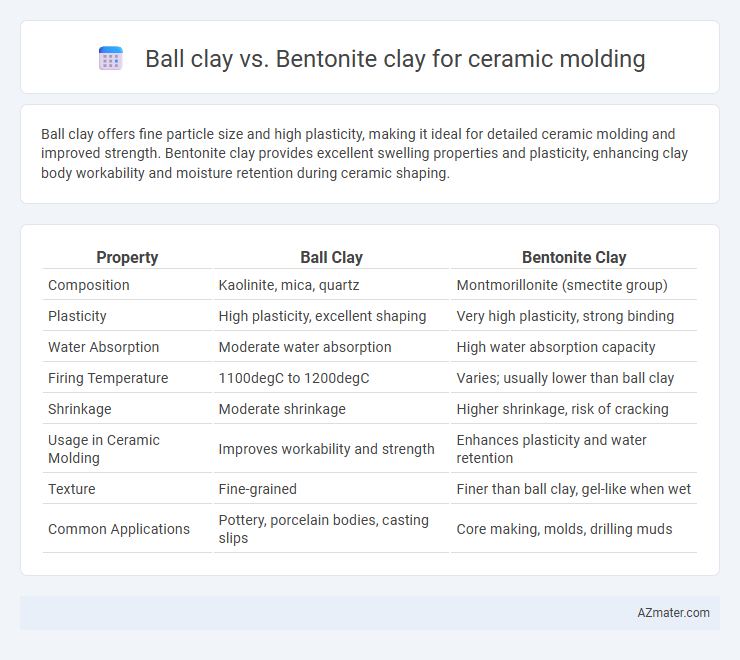Ball clay offers fine particle size and high plasticity, making it ideal for detailed ceramic molding and improved strength. Bentonite clay provides excellent swelling properties and plasticity, enhancing clay body workability and moisture retention during ceramic shaping.
Table of Comparison
| Property | Ball Clay | Bentonite Clay |
|---|---|---|
| Composition | Kaolinite, mica, quartz | Montmorillonite (smectite group) |
| Plasticity | High plasticity, excellent shaping | Very high plasticity, strong binding |
| Water Absorption | Moderate water absorption | High water absorption capacity |
| Firing Temperature | 1100degC to 1200degC | Varies; usually lower than ball clay |
| Shrinkage | Moderate shrinkage | Higher shrinkage, risk of cracking |
| Usage in Ceramic Molding | Improves workability and strength | Enhances plasticity and water retention |
| Texture | Fine-grained | Finer than ball clay, gel-like when wet |
| Common Applications | Pottery, porcelain bodies, casting slips | Core making, molds, drilling muds |
Introduction to Ball Clay and Bentonite Clay
Ball clay and bentonite clay are two essential materials used in ceramic molding, each offering unique properties that influence the shaping and firing processes. Ball clay is highly plastic, fine-grained, and composed primarily of kaolinite, silica, and mica, which provides excellent workability and strength to ceramic bodies. Bentonite clay, rich in montmorillonite, exhibits strong swelling and binding capabilities, making it ideal for improving the plasticity and green strength of molds and ceramic mixtures.
Geological Origins and Composition
Ball clay originates primarily from sedimentary deposits rich in kaolinite, mica, and quartz, formed through the weathering and fine particle settling in river valleys. Bentonite clay is derived from volcanic ash altered by weathering, predominantly composed of montmorillonite, a highly absorbent smectite mineral. The high plasticity and fine particle size of ball clay contrast with bentonite's swelling capacity and ion exchange properties, influencing their suitability for ceramic molding applications.
Physical Properties Comparison
Ball clay exhibits high plasticity and fine particle size, making it ideal for producing ceramics with smooth surfaces and good green strength. Bentonite clay, containing montmorillonite, has superior swelling capacity and water absorption, enhancing casting slip viscosity and suspension stability. Both clays differ significantly in particle morphology and moisture retention, influencing moldability and drying behavior in ceramic molding processes.
Plasticity and Workability
Ball clay offers superior plasticity and workability compared to bentonite clay, making it ideal for ceramic molding applications that require detailed shaping and smooth surface finishes. Bentonite clay, while highly plastic, tends to retain more water and shrink more during drying, which can cause warping or cracking in delicate ceramic forms. The balanced particle size and mineral composition of ball clay provide consistent flexibility and easier manipulation for precision ceramic work.
Water Absorption and Shrinkage Rates
Ball clay exhibits lower water absorption rates, typically around 20-25%, compared to bentonite clay, which can absorb up to 30-40% water due to its high swelling properties. The shrinkage rate of ball clay in ceramic molding generally ranges from 6-10%, offering more dimensional stability, whereas bentonite shows higher shrinkage of approximately 10-15%, which can cause warping or cracking during firing. These differences make ball clay preferable for molds requiring precise detail and minimal deformation, while bentonite is ideal for applications needing increased plasticity and water retention.
Firing Temperature and Thermal Behavior
Ball clay typically fires at temperatures between 1100degC and 1300degC, offering excellent plasticity and smooth texture ideal for fine ceramic molding with good thermal stability. Bentonite clay, often used as a binder, exhibits a lower firing temperature range around 900degC to 1100degC and demonstrates high shrinkage but exceptional water absorption, affecting thermal expansion and causing some instability at higher temperatures. The choice between ball clay and bentonite impacts ceramic molding by balancing firing temperature requirements with thermal behavior, where ball clay provides durability and dimensional stability, and bentonite enhances plasticity yet may reduce high-temperature performance.
Color and Texture Differences
Ball clay typically exhibits a creamy white to light tan color with a smooth, fine texture ideal for providing plasticity and strength in ceramic molding. Bentonite clay usually appears gray to dark brown and has a much finer, powdery texture known for its high swelling properties and excellent binding capacity. The color and texture differences influence the choice of clay, with ball clay preferred for its smoothness and color neutrality, while bentonite is chosen for its plasticity and moisture-retention in ceramic formulations.
Typical Applications in Ceramic Molding
Ball clay is commonly used in ceramic molding for its plasticity and strength, making it ideal for producing fine-grained, durable ceramics such as porcelain and sanitaryware. Bentonite clay is valued for its excellent binding properties and water absorption, often incorporated in slip casting and extrusion processes to improve mold release and structural integrity. Both clays serve distinct roles, with ball clay enhancing mechanical strength and surface finish, while bentonite aids in rheology control and mold performance.
Cost and Availability
Ball clay offers a cost-effective option for ceramic molding due to its abundant availability in regions such as the United States and the UK, making it a budget-friendly choice for large-scale production. Bentonite clay, while more expensive, provides superior plasticity and binding properties but is less widely available, often sourced from specific deposits in Wyoming and India. Manufacturers prioritize ball clay when balancing cost and supply reliability, whereas bentonite is reserved for applications requiring enhanced moldability despite higher prices.
Choosing the Right Clay for Your Project
Ball clay offers high plasticity and smooth texture, making it ideal for detailed ceramic molding that requires fine shaping and flexibility. Bentonite clay provides excellent water absorption and swelling properties, enhancing strength and workability in slip casting but may cause warping if overused. Selecting the right clay depends on balancing plasticity and drying behavior for the specific ceramic piece you intend to create.

Infographic: Ball clay vs Bentonite clay for Ceramic molding
 azmater.com
azmater.com